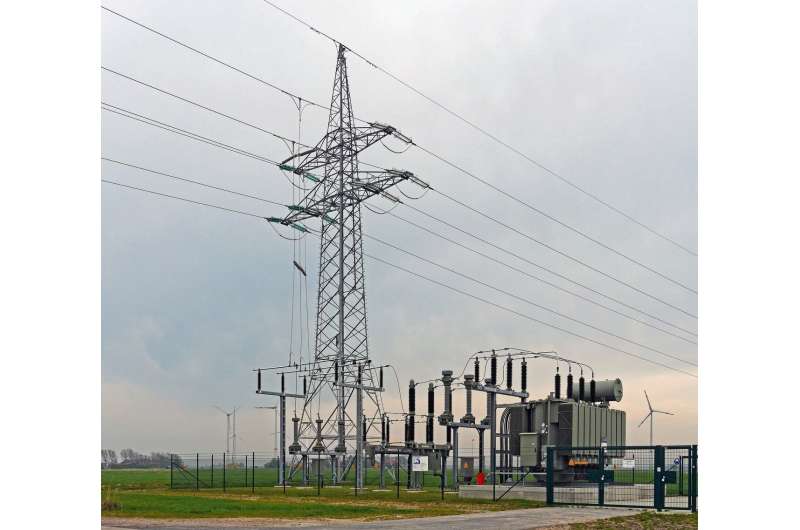This article has been reviewed according to Science X's editorial process and policies. Editors have highlighted the following attributes while ensuring the content's credibility:
fact-checked
trusted source
proofread
How AI is helping to ensure the security, reliability of the US energy infrastructure

Argonne scientists are leveraging the power of artificial intelligence to transform energy grid asset maintenance, helping U.S. power companies identify and address problems before they even occur.
America's need for power has never been greater, and it continues to grow—recent filings with the Federal Energy Regulatory Commission show grid planners expect demand to grow nearly 5% in the next five years. To meet the energy needs of the future, energy companies need to bring new plants online while maintaining their existing infrastructure.
Renewable energy sources—such as wind, solar and hydropower—will play an increasing role. The U.S. aims to generate 44% of its power from renewable resources in 2050, more than doubling the power currently generated by these new technologies.
Solar is expected to provide 22% of our power, with another 14% coming from wind. Integrating these new power sources into the grid will involve the installation of hundreds of millions of inverters, all of which will need to be maintained.
Meanwhile, parts of the existing grid are old and starting to fail. The average age of hydropower facilities in the U.S. is more than 70 years. Many are nearing the end of their operational lifespans and require extensive inspections and maintenance. The state of America's power lines, delivery networks and gas pipelines is even more concerning. The American Society of Civil Engineers gave these systems a grade of C- in 2021.
Monitoring and maintaining the health of this diverse suite of energy assets of different ages is crucial to ensure the reliability and security of our electric grid. However, power companies may not know there is a problem with their equipment until something breaks.
Researchers at the U.S. Department of Energy's Argonne National Laboratory are stepping in to address this need. Working closely with power companies across the energy sector, from aging hydropower plants to massive solar installations, they are reshaping the way companies approach maintenance of the nation's energy infrastructure and clean energy assets.
Using the latest in artificial intelligence (AI) technology, Argonne researchers developed AI-enabled software that could predict when grid components would fail. The system analyzes vast amounts of information energy companies collect from sensors installed throughout the grid, creating a predictive model that forecasts wear and tear over time. Ultimately, the software could recommend when to repair or replace parts before any problems occur.
"Companies want to know the health of their assets," said Feng Qiu, head of the Advanced Grid Modeling group at Argonne, who led this research. "Our prognostic models that leverage condition-monitoring information can tell them the useful remaining time of their equipment—how many years, months and weeks it has left."
Shijia Zhao, an energy systems scientist at Argonne who played a crucial role in the research, explains that their approach goes beyond traditional reactive maintenance strategies. "Instead of waiting for equipment to break down, we use AI to proactively identify potential issues and schedule maintenance just-in-time, saving both time and money for energy companies."
At the heart of this innovative approach is the ability to estimate infrastructure and asset health, predict failure risks and adapt maintenance decisions based on current real-world data. By transitioning from lab models to data collected from the field, Argonne researchers have shown how useful this technology can be to energy providers.
In one project on solar inverters, the team showed that it could potentially reduce total maintenance costs by 43%–56%, unnecessary crew visits by 60%–66% and increase profit by 3%–4%.
"Our goal is to equip energy providers with the tools they need to ensure a reliable and resilient grid for years to come," said Qiu. "With this technology, companies can make informed decisions about when and how to repair or replace equipment, ultimately enhancing the overall efficiency, security and reliability of America's energy infrastructure."
The benefits of this research extend far beyond cost savings and efficiency gains. By minimizing downtime and addressing maintenance issues before they escalate, energy providers can enhance grid reliability and resilience, crucial factors in an era of increasing energy demand and an evolving energy landscape.
The power and scale of the AI-enabled prediction and optimization models means they can optimize maintenance at a grid level. "This is critical to keep your lights on," said Qiu.
By looking holistically at the electric grid—from power plants to power lines—the models can predict failures in the entire network that produces and transports electricity from where it is generated to where it is consumed.
In the U.S., there are more than 240,000 high-voltage transmission lines and 50 million transformers. Most of the large and expensive transformers are near the end of their lifespan. About 70% have been in service for 25 years or more. Increasing load and volatile renewable energy integration are pushing an aging power grid to the limit.
That is why Argonne is providing this asset health management tool to operators. This will help ensure the future reliability and security of our electric grid. But it will also level the playing field, providing small energy companies with the same cutting-edge technology as the major corporations.
Qiu's team is quick to note that this research would not have been possible without close collaboration with their partners in the energy industry. Their long list of partners includes power companies as well as representatives from the areas of hydropower, solar power, and wave energy, and academia such as Wayne State University and Iowa State University.
"Our research represents a collaborative effort between scientists, engineers and industry partners," Zhao noted. "Together, we're driving positive change and shaping the future of energy grid maintenance."


















